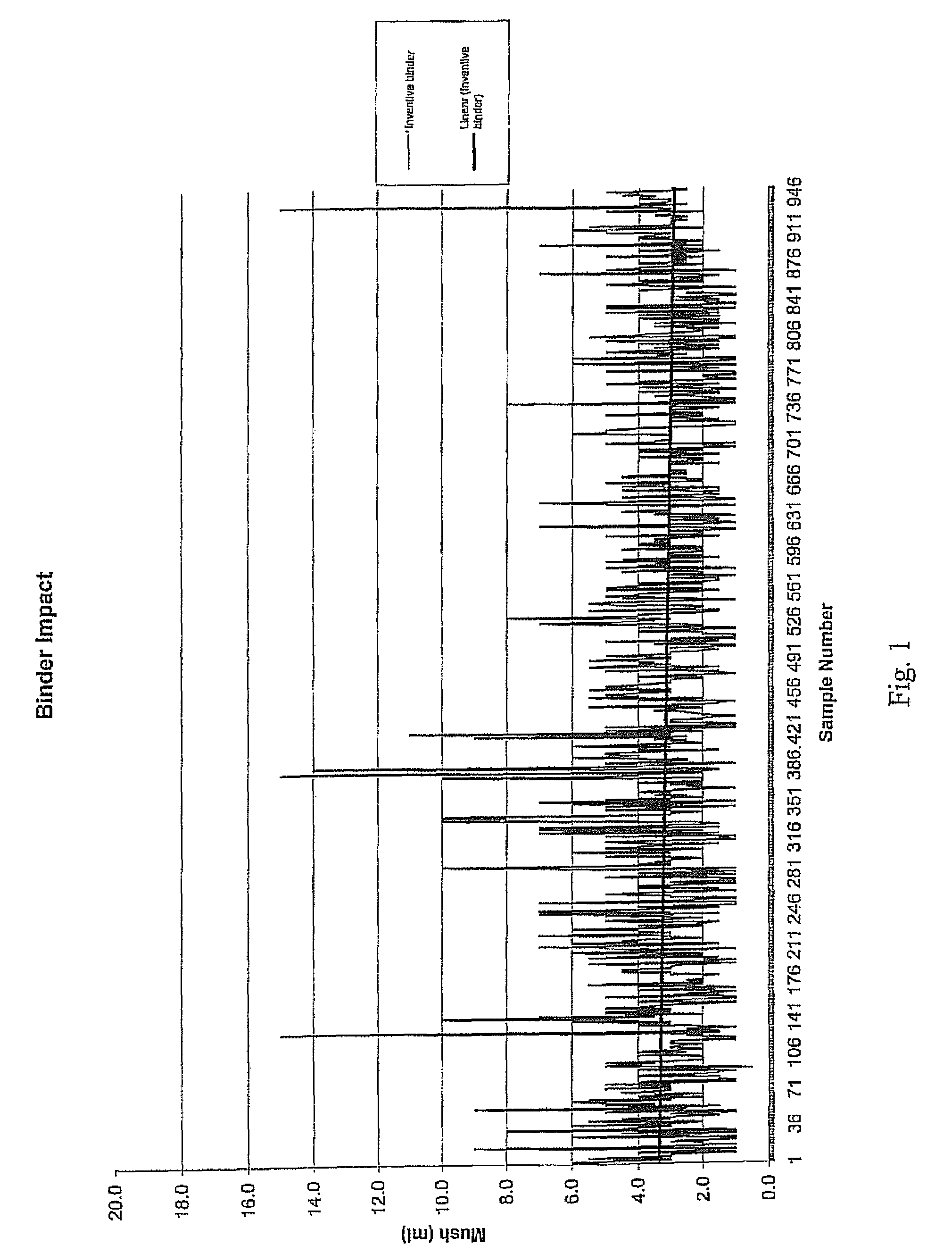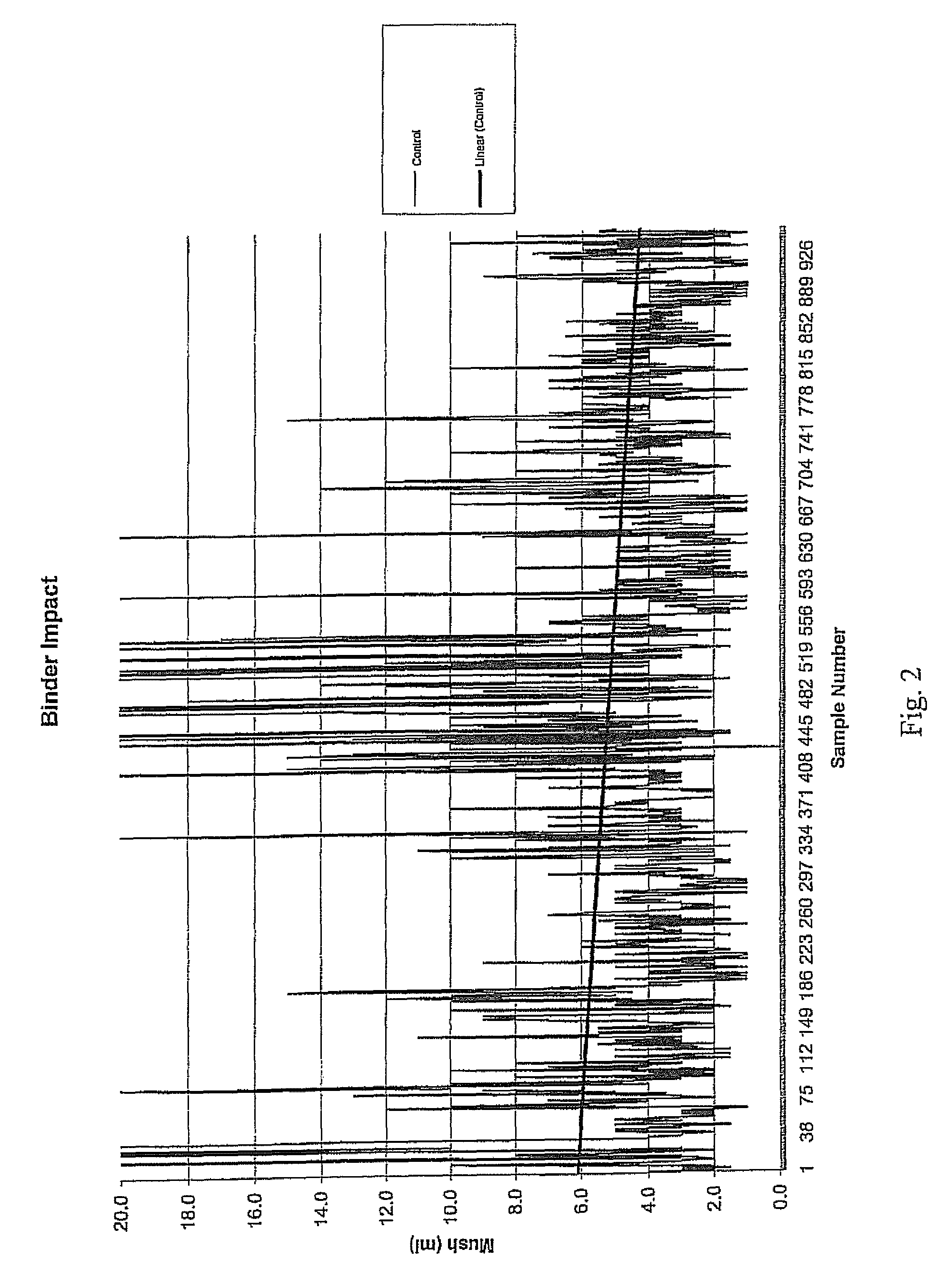Binding agent for compacted salt
a technology of binding agent and compacted salt, which is applied in the field of binding agents, can solve the problems of hard water, less detergent effectiveness, scale build-up in water lines, etc., and achieve the effect of minimizing or avoiding mushing
- Summary
- Abstract
- Description
- Claims
- Application Information
AI Technical Summary
Benefits of technology
Problems solved by technology
Method used
Image
Examples
example 1
Preparation and Analysis of Inventive Binder
[0027]A 45% SHMP (sodium hexametaphosphate, obtained from Innophos) solution was prepared by mixing 525 g of SUMP with 1 liter of water. Sorbitol (containing 30% water) was obtained from SPI Polyols. The SUMP solution and sorbitol were mixed at a volume ratio of 1.9 SHMP solution to 1 part sorbitol to form the inventive binder.
[0028]The final binder had a freezing point (ASTM No. D 1177) of 19° F. (−7-22° C.) whereas sorbitol freezes or crystallizes at 59.8° F. (15.44° C.) and a 45% solution of SHMP freezes at 28.9° F. (−1.72° C.). This is a significant and unexpected decrease in freezing point, and it decreases or even eliminates the need for heaters when storing the binder and / or the final salt product containing the binder.
[0029]The viscosity of the inventive binder was determined using a Brookfield Viscometer (60 rpm, #2 spindle). The inventive binder's viscosity at 20° C. (68° F.) was 17 cP, whereas the viscosity of sorbitol was 157 c...
example 2
Preparation of Salt Including Inventive Binder
[0030]A compacted salt containing the inventive binder of Example 1 was prepared by using a conventional compacting process. More specifically, NaCl crystals were conveyed from an evaporator, at a temperature of about 150° F. The binder of Example 1 was then contacted with the salt crystals, and the binder-coated salt product was conveyed to a 2-roll compactor (as described previously). During compaction, the crystals were exposed to 2,000 psi of pressure, and the temperature of the salt crystals increased by about 10-20° F. A sheet of recrystallized salt (with the binder interspersed with the salt) exited the compactor and was contacted with a sheet breaker, which broke the sheet into salt pieces. The pieces were screened so that all pieces ¼″ or larger were bagged, while all pieces smaller than ¼″ were recycled back to the beginning of this process.
example 3
Analysis of Salt Including Inventive Binder
1. Mush Test
[0031]A “mush test” was performed on this salt product. In this test, material was first screened so that the pieces tested had a minimum size of ¼″ and a maximum size of 1.25″. Next, 861 g of the salt was placed in a “V” cone (Patterson-Kelly “V” cone-type mixer), and 1,000 mL of water were added. The “V” cone was sealed and rotated at a speed of 23 rpm for 2 hours at ambient temperatures (about 70° F.), resulting in a saturated brine solution containing approximately 500 g of excess salt.
[0032]The saturated brine solution was then decanted from the “V” cone into a beaker and retained for later washing. The solution was poured into an 8-mesh screen with a funnel attached at the bottom, positioned upon an Imhoff cone. The previously-decanted, saturated brine solution was poured over the top of the compacted product to wash any fine material into the Imhoff cone. This brine solution washing step was repeated two more times, and t...
PUM
| Property | Measurement | Unit |
|---|---|---|
| freezing point | aaaaa | aaaaa |
| freezing point | aaaaa | aaaaa |
| freezing point | aaaaa | aaaaa |
Abstract
Description
Claims
Application Information
 Login to View More
Login to View More - R&D
- Intellectual Property
- Life Sciences
- Materials
- Tech Scout
- Unparalleled Data Quality
- Higher Quality Content
- 60% Fewer Hallucinations
Browse by: Latest US Patents, China's latest patents, Technical Efficacy Thesaurus, Application Domain, Technology Topic, Popular Technical Reports.
© 2025 PatSnap. All rights reserved.Legal|Privacy policy|Modern Slavery Act Transparency Statement|Sitemap|About US| Contact US: help@patsnap.com


